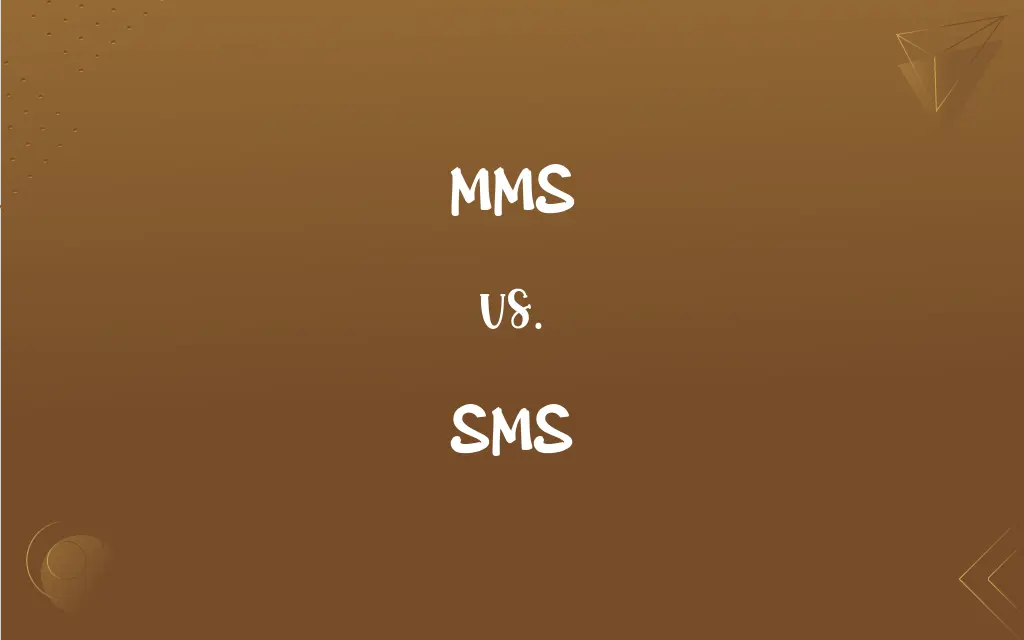MMS vs. SMS: What's the Difference?
Edited by Aimie Carlson || By Harlon Moss || Updated on October 18, 2023
MMS (Multimedia Messaging Service) allows sending multimedia content, while SMS (Short Message Service) is for text-only messages up to 160 characters.

Key Differences
MMS, or Multimedia Messaging Service, enables users to send multimedia content like pictures, videos, and audio clips in their messages. SMS, standing for Short Message Service, is limited to sending text-only messages without any multimedia attachments.
When using MMS, one might encounter slightly higher costs than with SMS, as the former involves transmitting more data. While SMS has been a staple in mobile communication for its simplicity and cost-effectiveness, sending only concise text messages.
Compatibility is a factor when considering MMS and SMS. Virtually every mobile phone can receive an SMS, but not all devices support MMS or might require specific settings to view multimedia content.
The underlying technology of MMS and SMS is different. SMS utilizes the standard telephony protocol, fitting messages within the bandwidth of regular phone communication. MMS, on the other hand, requires data networks to send multimedia, utilizing a different technical protocol.
Speed and delivery are other aspects where MMS and SMS might differ. While SMS is often immediate, MMS can take longer to send and receive due to the larger size and need for data networks, which might be slower than standard telephony networks.
ADVERTISEMENT
Comparison Chart
Content Type
Multimedia (images, videos, audio)
Text-only
Data Usage
Typically higher due to multimedia content
Minimal, text-based only
Compatibility
Requires devices and networks that support multimedia
Universally compatible with mobile devices
Technical Protocol
Uses data networks
Uses standard telephony protocol
Delivery Speed
Can be slower due to data transfer
Often immediate
ADVERTISEMENT
MMS and SMS Definitions
MMS
A text message enhanced with multimedia.
My phone buzzed, alerting me of a new MMS with a voice note.
SMS
A concise way to relay information via phone.
An SMS alert informed her of the bank transaction.
MMS
A service for richer, multimedia communication.
The MMS showcased a montage of their wedding photos.
SMS
A service to send short text messages.
I received an SMS with the meeting details.
MMS
A messaging service for multimedia content.
She sent an MMS with photos from her vacation.
SMS
Text-only communication on mobile devices.
He sent an SMS to confirm the time.
MMS
A way to send images, videos, or audio via text.
The MMS took a minute to download because of the video clip attached.
SMS
Mobile communication without multimedia.
Her phone beeped with an SMS reminder for the appointment.
MMS
The next step in messaging after SMS.
Instead of describing the concert, he sent an MMS with a snippet of the performance.
SMS
A messaging system limited to 160 characters.
The SMS contained directions to the venue.
FAQs
A service to send short text messages.
I received an SMS with the meeting details.
Text-only communication on mobile devices.
He sent an SMS to confirm the time.
A concise way to relay information via phone.
An SMS alert informed her of the bank transaction.
Mobile communication without multimedia.
Her phone beeped with an SMS reminder for the appointment.
Can I send videos through SMS?
No, videos are sent through MMS.
What does MMS stand for?
MMS stands for Multimedia Messaging Service.
Is SMS text-only?
Yes, SMS is a text-only messaging service.
Can MMS include text?
Yes, MMS can include both multimedia and text.
A messaging system limited to 160 characters.
The SMS contained directions to the venue.
Why is MMS not working on my phone?
MMS requires specific settings and a data connection; check with your service provider.
How secure is SMS?
Basic SMS lacks end-to-end encryption, making it less secure than some other messaging options.
Can I send SMS from the internet?
Yes, many online platforms allow sending SMS from the web.
How long can an MMS video be?
The length varies by carrier and device, but there's typically a size limit for MMS.
Are MMS messages more expensive than SMS?
Often, MMS can be costlier due to higher data usage.
Can all mobile phones receive MMS?
Not all, the device and network need to support multimedia messaging.
Why is my SMS not being delivered?
It could be due to network congestion, invalid recipient number, or other technical issues.
How does MMS work technically?
MMS utilizes data networks and requires an MMS gateway to function, separate from standard SMS protocols.
Why can't I view the MMS I received?
It could be due to incompatible device settings or lack of data connectivity.
What's the history of SMS?
SMS was developed in the 1980s as part of the GSM mobile communication standard.
Can I send group messages via SMS?
Yes, but group messaging often utilizes MMS protocols, especially if media is included.
How do I know if I've received an MMS or SMS?
Your device usually differentiates them, and MMS often requires downloading the content.
Does MMS quality degrade the original media?
Often, MMS may compress media to meet size constraints, which can reduce quality.
Is there an alternative to SMS and MMS?
Many instant messaging apps like WhatsApp or iMessage offer text and multimedia messaging over the internet.
Is there a character limit for SMS?
Yes, SMS messages have a 160-character limit.
Can I send music through MMS?
Yes, you can send short audio clips using MMS.
About Author
Written by
Harlon MossHarlon is a seasoned quality moderator and accomplished content writer for Difference Wiki. An alumnus of the prestigious University of California, he earned his degree in Computer Science. Leveraging his academic background, Harlon brings a meticulous and informed perspective to his work, ensuring content accuracy and excellence.
Edited by
Aimie CarlsonAimie Carlson, holding a master's degree in English literature, is a fervent English language enthusiast. She lends her writing talents to Difference Wiki, a prominent website that specializes in comparisons, offering readers insightful analyses that both captivate and inform.































































